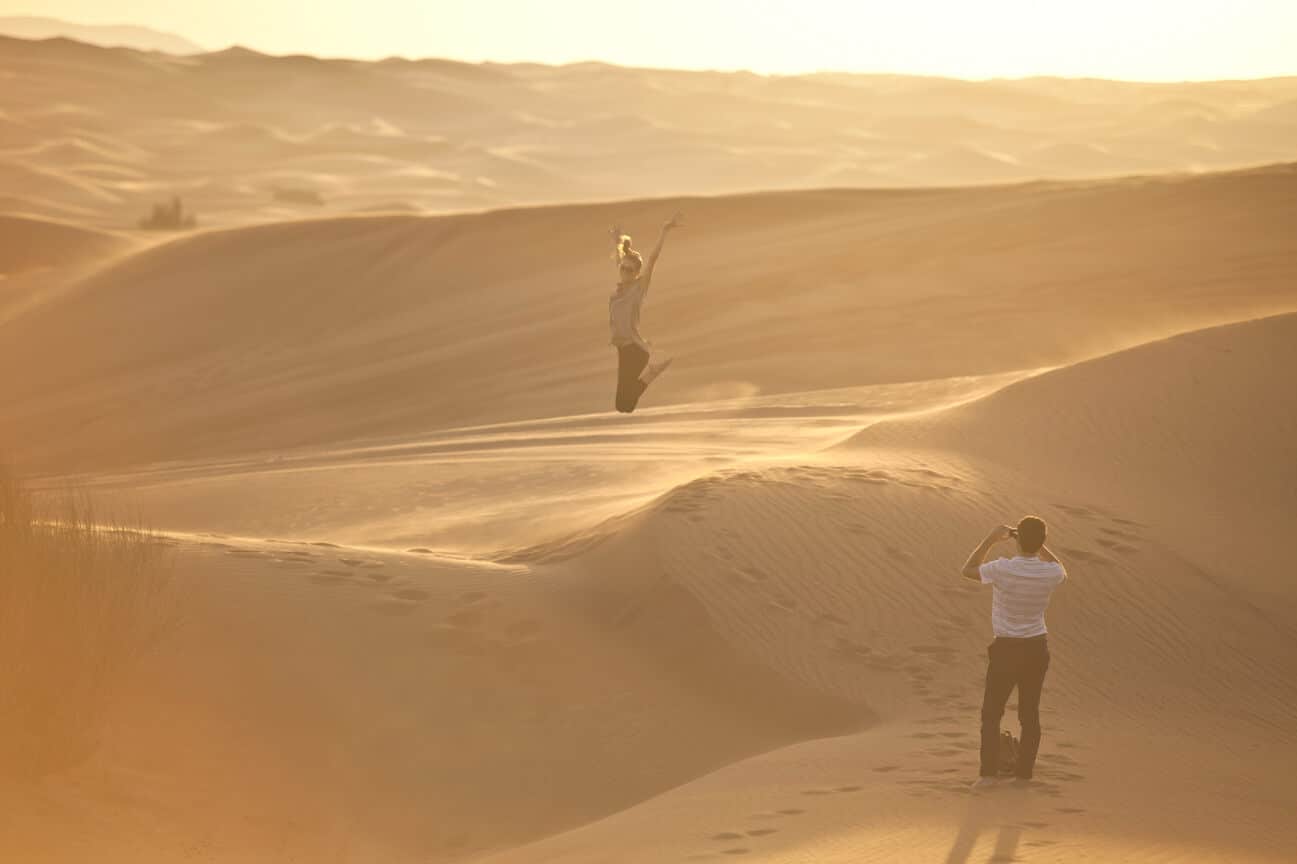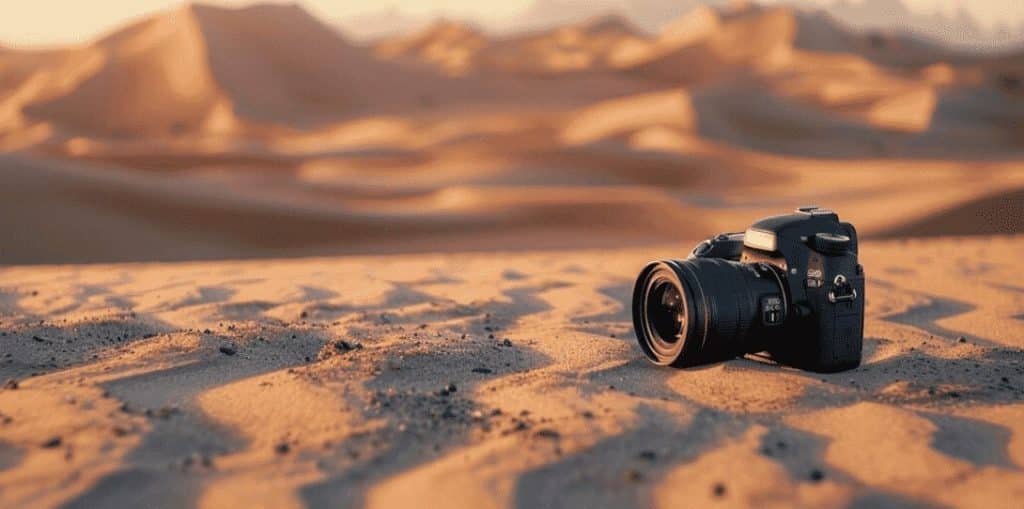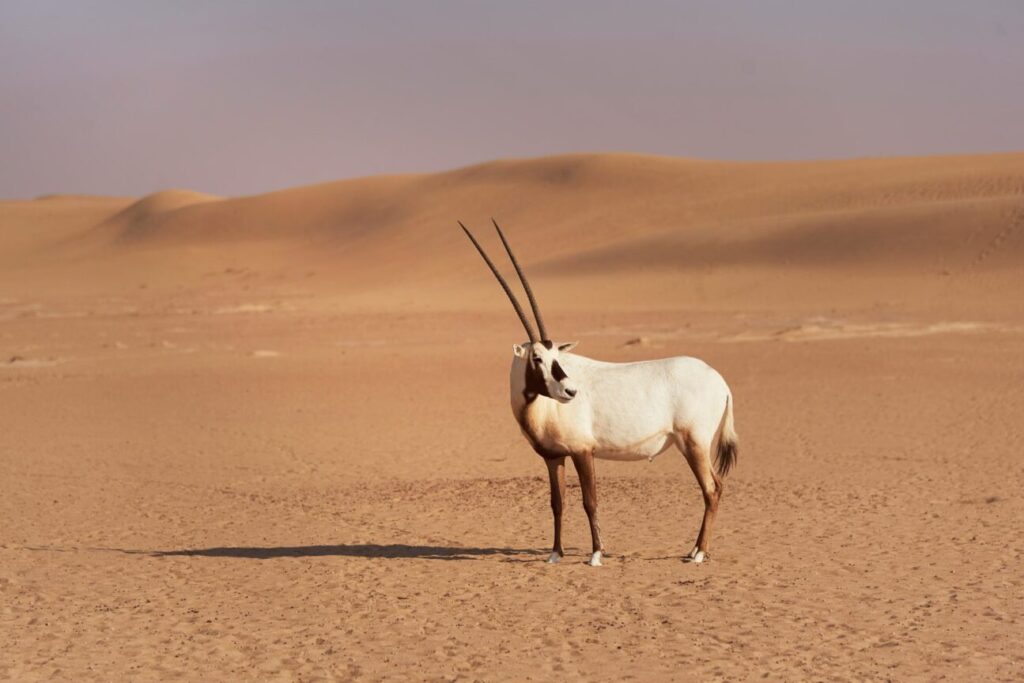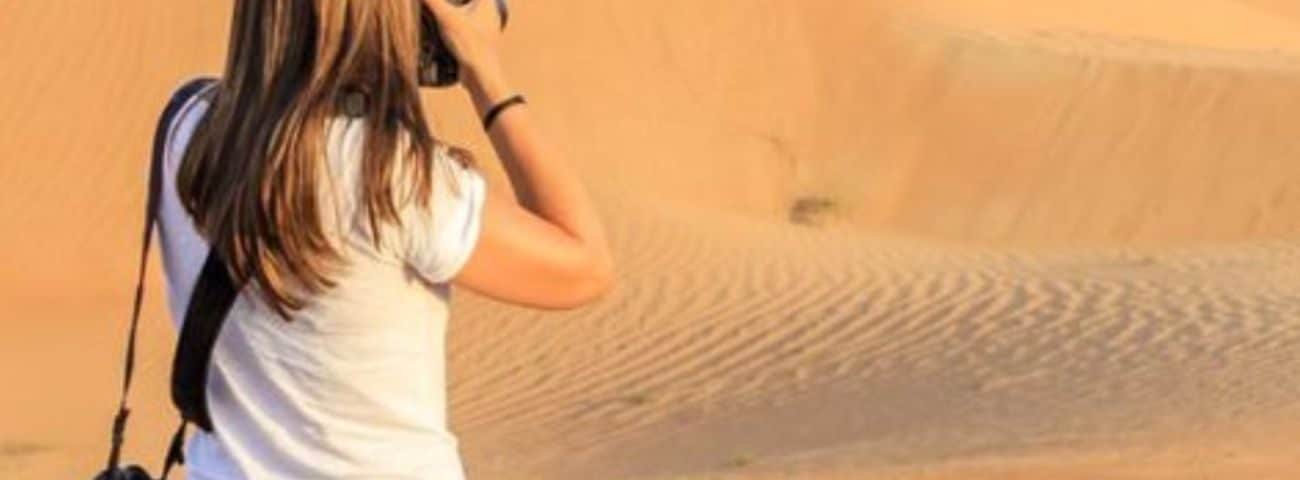A desert safari in Dubai results in the most unusual and exhilarating adventure. The magical golden sands, astounding dunes, and deep cultural experiences set an astounding backdrop for some of the most stunning photography ever captured. But to catch the desert’s raw beauty, one has to prepare, know the ideal time, and understand the ways of aligning with nature. This Dubai photography guide offers practical tips on attaining perfect desert safari shots, must-have equipment, photography guidance for landscapes and wildlife, cultural shows, etc., and suggestions to keep your gear harmless all over the tough desert conditions.
Desert Safari Photography : Tried and Tested Tips

Knowing the best time for desert photos in Dubai is highly imperative for capturing brilliant desert pictures. The golden hour, the time following sunrise or before sunset, spreads soft, warm light across the desert, dramatically shadowing it and giving it the radiance of magic. The blue hour, just previous to sunrise or subsequent to sunset, will add an ethereal quality to your shots. While midday light may be harsh, it certainly creates high-contrast images and vivid colors that can be best exploited in bold, minimalist shots. Overall, it leads to great lighting and depth in pictures.
There are myriad desert places in Dubai to get a photoshoot; each of them has its own exceptional touch and beauty. Research the diverse locations with respect to accessibility, the shooting permits essential, and the sight each area has to present. Choose it from the Dubai Desert Conservation Reserve’s high dunes or the Lahbab Desert’s stillness. They will surely fit your passions for Dubai Desert Safari photography and gorgeous desert scenery.
3. Secret Weapon : The Right Photography Equipment for Desert Captures
Top-notch photography equipment for desert captures includes,

Use a mirrorless camera or SLR with manual settings tuned to the existing light conditions, allowing you to better manage photography through shutter speed, changeable aperture, and ISO through sophisticated manual controls. It is true; this is not restricted to a specific camera type. Even a smartphone can produce good results if only the beholder knows how to precisely shoot with it.
To showcase the desert’s space and size, opt for wider angles. The zoom lens can assist you in capturing the camels or the far-away desert dunes, when needed.
It’s an indispensable accessory for ensuring steadiness in the captured shots, especially under situations of low light. It is also handy for long-time exposures to attain moving sand-or night sky kind of shots.
The polarizing filter is imperative for outdoor photography, as it reduces any glare from the sand and augments hues of the sky. For example, neutral density (ND) filters allow for gradual shutter speeds even in brilliant sunlight, a wonderful means to record movement of people or the sand’s blowing rhythm.
Another great alternative is to get a drone to document aerial shots of the most instagrammable spots in Dubai desert. The dunes’ undulating waves and the desert’s extensive expanse lend themselves best to an above view. Awareness of local drone regulations in Dubai will let you fly it dutifully.
Desert heat saps batteries quickly. If you want to explore time in the desert, carry additional batteries with you. Pack memory cards, as you will take lots of photos in this magnificent place because there is always something screaming to be photographed in one of the top deserts in the world.
Desert photography is utterly reliant on the composition. The large coverage of the desert sometimes becomes an obstacle in assessing a focal point. So lead the eye through the picture with leading lines, such as the edges of dunes or a car’s path. Add a subject to the foreground, like a single tree, a lovely camel, or even an individual, as it adds curiosity and gives scale to the image. You should really have these techniques in your arsenal when learning how to photograph desert landscapes well, so your pictures capture the grandeur of the desert beauty.
Adhere to the famed rule of thirds to advance photography by arranging vital components alongside the gird lines. Most smartphones are equipped with a grid of nine squares that can turn on. Putting subjects like the dunes, horizon, or people along such lines creates a more objective, dynamic, and visually pleasing composition in your shots. Try it out and see how successful it works.
Try evaluating angles and perspectives to add spice to your lovely desert shots. Consider low angles to catch the fine textures of the dunes, or climb high for sweeping sights of the cosmic landscape. Shifting height and position is one of the essential desert photography tips that can help you make more vibrant photographs and show off the inimitable splendor of the desert as seen from a number of perspectives.
When planning unmissable things to do on desert safari, especially a safari photo shoot be sure to check the weather forecast. Acute weather conditions like sand storms or high winds may make it unfeasible to shoot. Safety always comes first, so you should take defense like bringing adequate water, dabbing sunscreen, and dressing in line with the weather conditions. It is better to check with your photographer and follow their opinion if you experience any abrupt weather conditions upsetting your photo shoot.

One perk of Dubai’s evening desert safari photo shooting is the accessibility of natural elements, augmenting your pictures. The mammoth sand dunes, the cosmic open spaces, and even a sporadic wildlife encounter can form pieces of your compositions and generate some of the most eye-catching photographs. Utilize such natural elements for adding depth, consistency, and scale to your images, which better mirror the magnificence of the desert.
The desert is infinite with photographic opportunities. Places where you can go such as sweeping dunes, really great wildlife, and energetic cultural performances. Get the landscape with leading lines and use macro textures/a wide aperture by working out your micrology lens. Play tricks with shadows as well as lights for some striking effects, and utilize wide angles for that great vision to represent the desert’s vastness. For capturing wildlife in Dubai, utilize a telephoto lens and make certain to make eye contact to present a poignant aspect. For cultural exhibits, be sure to hold ISO at low light, fast lens, and play with the shutter speed for capturing movement and emotion. As usual, patience will forever be the crucial factor, as it will always bring admiration towards your subjects.
When attempting to document gorgeous wildlife images in the Dubai desert, you should not try to get in touch with wild animals, lest you upset their behavioral patterns. Telephoto lenses should be utilized for close-ups. Ask any local whether it is acceptable to photograph them, too.
As an ecstasy for photographers, golden hour, the time instantaneously prior to sunset, sets the desert landscape aglow. As the sunbeams illuminate the gorgeous dunes, forming soft shadows in their folds, everything is made just right. The Arabian Desert is a splendid habitat for several wildlife species, from sand gazelles to oryx and desert cats. You photograph them from a distance within the conservation reserves. The types of desert landscapes in this region, which include sandy paths and huge dunes scavenging red sands, are all picture-perfect scenes. Those are accessed either through camel rides or in a sturdy 4×4 vehicle. Evening safaris incorporate cultural shows, from belly dances to fire performances, just right for documenting cherished moments. The desert’s serenity and vivid, starry skies open up exciting prospects for capturing astonishing long exposures for night photography in desert safaris.
Experiment with post-processing to the maximum to perk up your desert images. Contrast, brilliance, and saturation adjustments will bring out some shades in the desert, and with the skillful adding of well-chosen filters; you can add some artificial fundamentals to your picture. Considering balance however, be careful because over-processing leads to deviant looking photos. Rather than completely altering the desert, bring out its exquisiteness within nature.
The milieu of sandy deserts could be hostile for your camera equipment; however, its attentive care could keep it protected. Storing equipments in dust-proof bags, using lens hoods for shading, and cleaning repeatedly with a supple brush or cloth are some methods to defend the camera. For protecting the camera in sand, keep spare batteries in an arid, cool place; otherwise, steer clear of compressed air.
It is time to divulge and flaunt those astounding desert safari moments, once you have accomplished the photographs. Generate an online portfolio/distribute the images via personal websites, social media, or good photography discussion forums. Team up with good local magazines while you are at it or even organize exhibitions for wider reach, and appreciation for your marvelous work.
Frequently Asked Questions (FAQs):
Q1. How to document top-notch images on a desert safari?
- Use top-tier quality camera
- Zoom lens
- Tripod
- Time the shot well
Q2. Can tourists document images in Dubai?
Typically, photography is permitted in Dubai for personal use, particularly for documenting tourist sites and famed attractions.
Q3. Does the UAE have any specific photography restrictions?
- Avoid documenting images of one’s personal moments
- Never capture any government/military facilities
- Do not document any activity that may appear impolite to local customs
- Avoid capturing snapshots inside a mosque or at the time of a religious festivity unless with explicit permission.
Q4. Is a specialized photographer included in desert safari packages?
A handful of safari trips come with options of letting you hire specialized photographers yet with an additional charge. For best recommendations, do review the latest guide on how to choose the best desert safari in Dubai .
